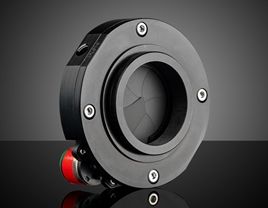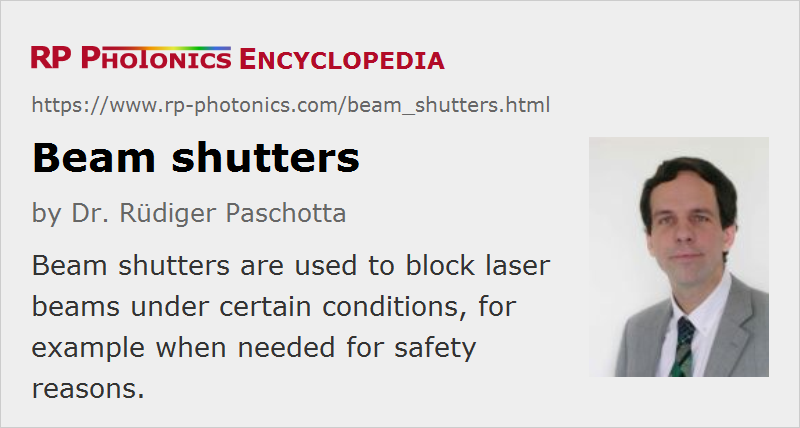Beam Shutters
Definition: devices for blocking or releasing light beams
German: Strahlverschlüsse
How to cite the article; suggest additional literature
Author: Dr. Rüdiger Paschotta
If a laser beam is unwanted at certain times, one may in principle turn off the laser. This, however, is not always practical; particularly high-power lasers are often designed to operate continuously over longer times and need some warm-up time before reaching full performance. Therefore, one often uses a beam shutter for blocking a beam when required.
Beam shutters typically interrupt or release a beam by inserting or removing an absorbing or reflecting blade. This process may be controlled manually, but often there is an electromechanical actuator for remote-controlled and/or automatic operation. For example, beam shutters are often connected to laser safety interlocks so that laser hazards are avoided e.g. when a laser enclosure is opened. For fail-safe operation, a shutter device may be made such that it automatically closes when its control signal disappears – for example, simply with a spring or based on gravity. The risk of jamming should be minimized with an appropriate design.
Switching times can be quite different – often of the order of 10 ms, but sometimes well below 1 ms. For laser safety applications, particularly fast switching is often not required. A more important aspect is the reliability of blocking the beam.
In the open state, a beam shutter should have no effect on the laser beam at all, assuming that its open aperture is large enough for the beam. In the closed state, the whole laser power should be safely dissipated, without causing reflections back into the laser or significant stray light.
There are also diaphragm beam shutters with multiple blades, where the opening starts in the center of the beam rather than from the side. The extent of shutter opening may be varied, e.g. for adjusting the level of illumination.
In some cases, one may use a shutter device without moving parts – for example, an electrically controlled optical attenuator based on a liquid crystal modulator Such devices differ substantially from regular beam shutters. For example, they may not provide complete transmission or complete blocking, their operation is polarization-dependent, and the power handling capability is limited. This article focuses on beam shutters with moving parts.
Comparison with Optical Choppers
In contrast to optical choppers, laser beam shutters are usually not operated periodically and used only for low switching frequencies (e.g. up to 10 Hz) and for a moderate amount of switching cycles in their lifetime. For example, a laser safety beam shutter may be activated only a few times per day. Some beam shutters, however, are designed for several millions of switching cycles in their lifetime.
Power Handling
Beam shutters are often designed to withstand substantial laser powers. For lasers with moderate optical power (e.g. up to a few watts), a beam shutter may simply contain a robust absorber. For higher power levels, it may contain a movable mirror for directing the beam into a beam dump, which may be fan-cooled or water-cooled. In some cases, there should be a good thermal contact to the base plate on which the shutter is mounted.
Overheating a shutter by operation with too high optical power in the closed state (or for too long time under such conditions) may result in permanent damage, or to temporary failure of the shutting mechanism.
In any case, a laser beam with significant optical power should not be sent into a beam shutter with a too small beam radius, because otherwise the absorber could be damaged.
Electronic Controller
Laser beam shutters are often provided together with suitable electronic controllers. The controller may need to provide a certain voltage for switching but only a significantly lower voltage (and current) for holding the shutter open. That feature will not only limit the heating of the actuator and the power consumption, but may also allow for quicker closing.
There are stand-alone controllers with a front panel for interaction with the user; others are made for integration into other devices as OEM laser modules. A shutter driver may also be included in a laser interlock device.
Additional Features
Controllers often allow manual triggering with buttons on the front panel. Some can be programmed e.g. to produce certain open/close sequences with precise timing.
A key switch may be used to ensure that only an authorized person, having the key, can open the beam path.
Some devices have a digital interface, e.g. of TTL, USB or RS-232 type. In case of USB, it is sometimes possible to also obtain electrical power in that way, thus not requiring a separate power cable and adapter. The received input signals may not only directly open or close the shutter, but also trigger pre-programmed operation sequences, or program such sequences. There may also be a return channel e.g. for checking the state of the device.
There may be in additional safety interlock input, with which the opening by the regular control signal can be blocked.
Some laser beam shutters contain an electronic sensor for checking whether the shutter has really opened or closed. This can be useful to detect defects, which may otherwise have dangerous consequences. While such a defect is detected, the controller may provide of warning for users and/or transmit a signal to other devices.
Suppliers
The RP Photonics Buyer's Guide contains 17 suppliers for beam shutters. Among them:


Edmund Optics
Beam shutters are used to control the level of light exposure to an optical lens or lens system in a range of applications such as imaging or microscopy. Shutters are manually or motor controlled irises that may be opened or closed to control the level of light that passes through the aperture. Shutters provide an accurate, stable level of light transmission that may be easily adjusted or maintained for repeated implementation. A number of motorized shutters are also available that include several iris control modes for increased versatility.
Questions and Comments from Users
Here you can submit questions and comments. As far as they get accepted by the author, they will appear above this paragraph together with the author’s answer. The author will decide on acceptance based on certain criteria. Essentially, the issue must be of sufficiently broad interest.
Please do not enter personal data here; we would otherwise delete it soon. (See also our privacy declaration.) If you wish to receive personal feedback or consultancy from the author, please contact him e.g. via e-mail.
By submitting the information, you give your consent to the potential publication of your inputs on our website according to our rules. (If you later retract your consent, we will delete those inputs.) As your inputs are first reviewed by the author, they may be published with some delay.
See also: optical choppers, interlocks, laser safety
and other articles in the category photonic devices
 |




If you like this page, please share the link with your friends and colleagues, e.g. via social media:
These sharing buttons are implemented in a privacy-friendly way!